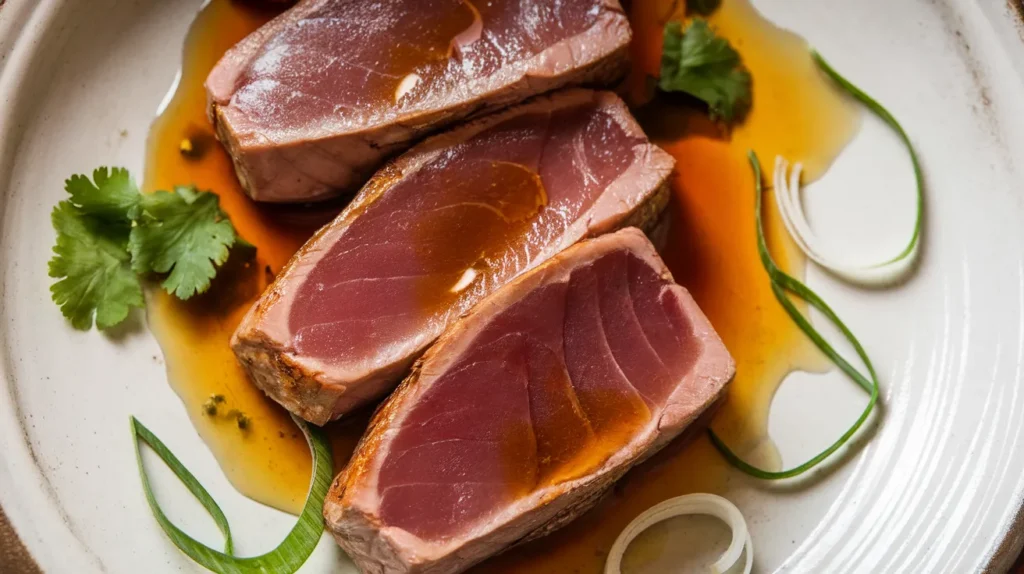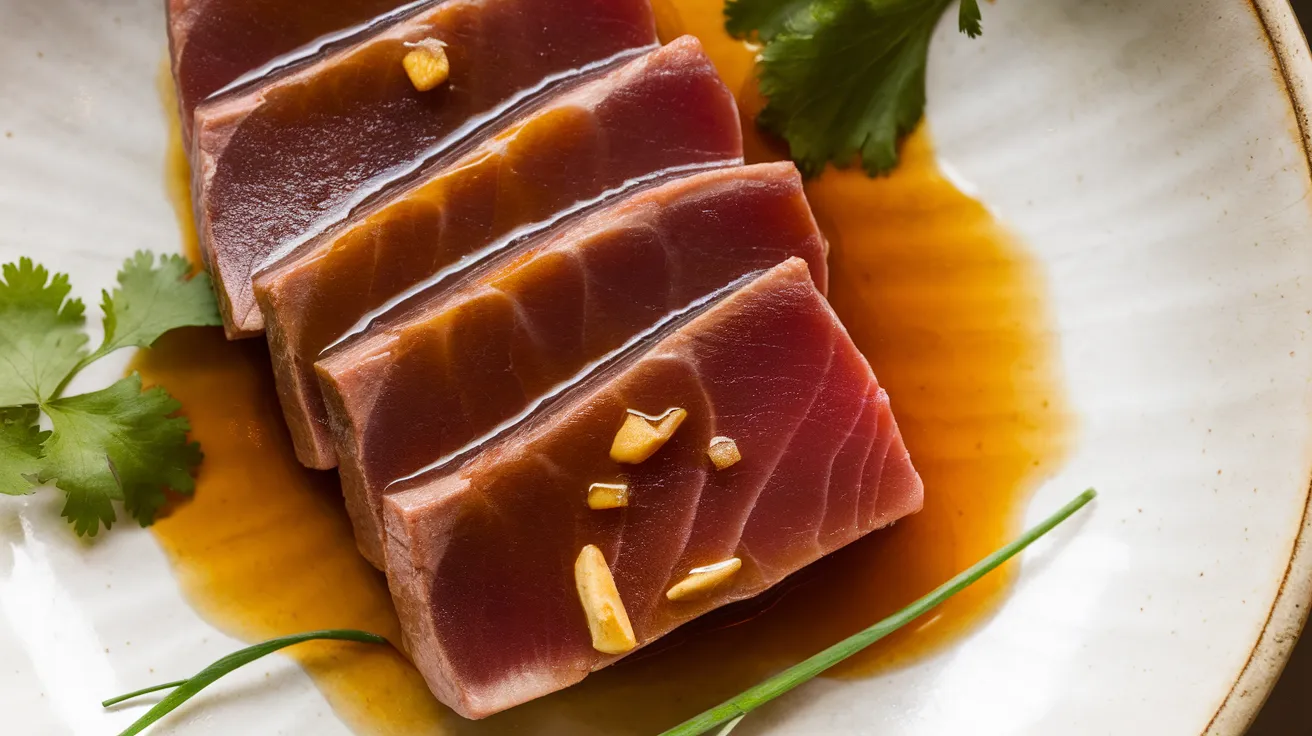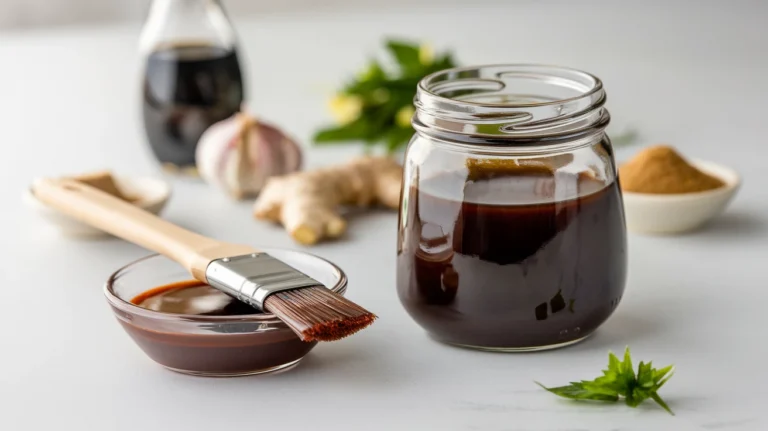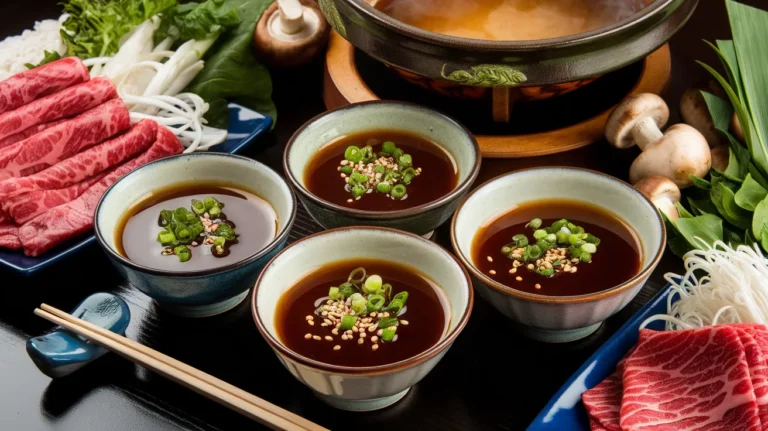This restaurant-style sauce for tuna steak brings bold Asian-inspired flavors to your dinner table with incredible ease. Our sauce for tuna steak recipe combines sweet honey, tangy rice vinegar, and aromatic sesame oil to create the perfect complement for seared tuna steaks that will impress family and guests alike.
SERVES: 4 | PREP: 15 MIN | COOK: 10 MIN | TOTAL: 25 MIN
Ingredients
For the Sauce Base
| Ingredient | Amount | Notes |
|---|---|---|
| Soy sauce | 1/4 cup | Low-sodium preferred |
| Rice vinegar | 2 tablespoons | Adds bright acidity |
| Sesame oil | 1 tablespoon | Toasted variety |
| Honey | 2 tablespoons | Pure, not artificial |
| Fresh ginger | 1 tablespoon | Finely grated |
| Garlic cloves | 3 medium | Minced fresh |
For the Flavor Enhancers
| Ingredient | Amount | Notes |
|---|---|---|
| Lime juice | 2 tablespoons | Fresh squeezed only |
| Green onions | 3 stalks | Thinly sliced |
| Cilantro | 1/4 cup | Fresh leaves, chopped |
| Red pepper flakes | 1/2 teaspoon | Adjust to taste |
| Cornstarch | 1 teaspoon | For thickening |
| Water | 1 tablespoon | For cornstarch slurry |
Complete Step-by-Step Sauce for Tuna Steak Instructions
Phase 1: Essential Preparation (8-10 minutes)
Step 1: Create the Perfect Cornstarch Slurry In a small bowl, measure 1 teaspoon cornstarch. Add 1 tablespoon cold water gradually while whisking with a fork. Continue whisking for 30 seconds until completely smooth with no visible lumps. The mixture should look like thick cream. Set this aside – we’ll use it later to thicken our sauce for tuna steak. Why this matters: Adding cornstarch directly to hot liquid creates irreversible lumps that will ruin your sauce texture.
Step 2: Prepare Fresh Ginger Like a Pro Using a spoon, scrape the skin off 1-inch piece of fresh ginger root. The spoon method removes just the thin skin without wasting ginger flesh. Using a microplane grater or fine box grater, grate the ginger in short, quick strokes. You need 1 tablespoon of finely grated ginger. Work slowly to avoid scraping your knuckles. Fresh ginger provides bright, spicy heat that powdered ginger cannot match. Pro tip: Freeze ginger for 15 minutes before grating – it grates easier and produces finer pieces.
Step 3: Master the Garlic Mince Remove papery skin from 3 medium garlic cloves. Place flat side of chef’s knife over each clove and press firmly to crush slightly – this makes peeling easier. Using a sharp knife, slice each clove into thin pieces, then rock the knife back and forth to mince into tiny, uniform pieces about 1/8-inch in size. Uniform pieces ensure even cooking and prevent some pieces from burning while others stay raw. Safety note: Keep fingertips curved under and knuckles forward when cutting.
Step 4: Prep Green Onions Properly Rinse 3 green onions under cold water and pat completely dry with paper towels. Using kitchen shears or sharp knife, trim off root ends and any wilted green tops. Slice the white and light green parts (bottom 3 inches) into thin rounds about 1/8-inch thick. Separately, slice the dark green tops into thin pieces. We’ll use these at different times in our sauce for tuna steak recipe. Why separate them: White parts need cooking time to mellow, while green tops stay fresh and bright when added at the end.
Step 5: Prepare Fresh Cilantro Rinse fresh cilantro bunch in cool water and shake dry thoroughly. Remove thick stems, keeping only leaves and tender thin stems. Roughly chop into small pieces to make 1/4 cup. Don’t worry about perfect uniformity – rustic chopping looks more appealing in the finished sauce. Storage tip: Wrap remaining cilantro in damp paper towels and store in refrigerator for up to 1 week.
Step 6: Fresh Lime Juice Extraction Roll 2 limes firmly on counter while pressing down – this breaks internal membranes and releases more juice. Cut each lime in half crosswise. Using a fork or citrus reamer, extract juice while catching seeds in your other hand. You need 2 tablespoons fresh lime juice. Strain through fine mesh if any pulp or seeds slip through. Never substitute bottled lime juice – fresh provides essential bright acidity that bottled versions lack.
Phase 2: Building Your Sauce for Tuna Steak Base (5-6 minutes)
Step 7: Start the Sauce Foundation Place a small saucepan (2-quart size works perfectly) on stove over medium heat. Wait 1 minute for pan to warm evenly. Add 1/4 cup low-sodium soy sauce, 2 tablespoons rice vinegar, and 2 tablespoons honey. The pan should be warm but not hot enough to make the liquids sizzle aggressively. Temperature check: The mixture should bubble gently around edges, never boil vigorously.
Step 8: Dissolve Honey Completely Using a whisk, stir the mixture constantly for 1-2 minutes until honey completely dissolves. You’ll know it’s ready when the mixture looks uniform without streaky honey ribbons. The liquid should be warm to touch but not hot enough to steam heavily. This creates the sweet-salty-sour base that makes this sauce for tuna steak so special. Troubleshooting: If honey won’t dissolve, increase heat slightly for 30 seconds, then reduce back to medium.
Step 9: Add Aromatics Carefully Add your prepared minced garlic and grated ginger to the warm liquid. Stir immediately with whisk to prevent sticking. Cook for exactly 45 seconds to 1 minute, stirring constantly. You’ll smell amazing aromas – garlic should smell fragrant, not sharp. Ginger should release its spicy-sweet scent. If anything starts turning brown, immediately reduce heat. Critical timing: Undercooked garlic tastes harsh, overcooked garlic becomes bitter and ruins the sauce.
Step 10: Incorporate Oil and Heat Remove saucepan from heat temporarily. Add 1 tablespoon toasted sesame oil and 1/2 teaspoon red pepper flakes. Whisk vigorously for 30 seconds to blend oil evenly throughout the mixture. The sauce should look glossy and unified. Return pan to medium heat. Toasted sesame oil provides nutty depth, while red pepper flakes add gentle warmth without overwhelming heat. Oil tip: Toasted sesame oil has much more flavor than regular sesame oil – it’s worth seeking out.
Phase 3: Perfecting the Sauce for Tuna Steak Consistency (4-5 minutes)
Step 11: Achieve Perfect Simmer With pan back on medium heat, watch carefully for the first signs of simmering. You’ll see small bubbles forming around the edges, not a rolling boil in the center. This should take 1-2 minutes. The surface might shimmer slightly. Perfect simmering temperature allows flavors to meld without breaking down delicate ingredients. Visual cue: Think gentle jacuzzi bubbles, not volcanic eruption.
Step 12: Thicken with Cornstarch Slurry Give your prepared cornstarch slurry a quick whisk – it may have separated. With sauce at gentle simmer, slowly drizzle the slurry into the center while whisking the sauce constantly with your other hand. Don’t dump it all at once. Keep whisking for 30-45 seconds after adding. The sauce will transform from thin liquid to glossy, coating consistency that clings beautifully to tuna steaks. Technique tip: Pour slurry in thin stream while whisking in circular motion to prevent lumps.
Step 13: Test Thickness and Remove from Heat Lift whisk from sauce – properly thickened sauce should coat the whisk lightly and drip in thick ribbons, not watery streams. If too thin, whisk in tiny bit more cornstarch slurry. If perfect, immediately remove from heat. Overcooking thickened sauce makes it gummy and breaks down the cornstarch structure. Consistency goal: Think maple syrup thickness, not pudding thick.
Phase 4: Final Touches for Perfect Sauce for Tuna Steak (2-3 minutes)
Step 14: Add Acid Off Heat With saucepan removed from heat, immediately add your 2 tablespoons fresh lime juice and the white parts of sliced green onions. Whisk gently but thoroughly for 15 seconds. Adding acid off heat preserves the lime’s bright, fresh flavor that would become dull if cooked. The white onion parts will soften slightly from residual heat while maintaining some texture. Chemistry note: Heat breaks down citric acid, making cooked citrus taste flat and bitter.
Step 15: Incorporate Fresh Herbs Add half of your chopped fresh cilantro (save the rest for garnish) and whisk gently to distribute evenly. The residual heat will release cilantro’s essential oils without wilting the leaves completely. This creates layers of fresh flavor that complement the cooked aromatics. Herb tip: Fresh herbs added at the very end stay bright green and maintain their essential oil potency.
Step 16: Final Seasoning and Quality Check Taste your sauce for tuna steak carefully using a clean spoon. It should balance sweet (honey), salty (soy sauce), sour (lime and vinegar), and spicy (ginger and red pepper flakes). If too salty, add 1 more teaspoon honey. If too sweet, add 1 teaspoon more lime juice. If lacking punch, add pinch of salt. If too thick, whisk in 1 teaspoon warm water. Perfect balance: No single flavor should dominate – they should work together harmoniously.
Step 17: Garnish and Serve Immediately Transfer your completed sauce for tuna steak to serving bowl or small pitcher. Sprinkle remaining fresh cilantro and green onion tops over surface for beautiful presentation. Serve immediately while still warm for best flavor and consistency. The sauce should coat tuna steaks beautifully while allowing the fish’s natural flavor to shine through. Serving temperature: Warm or room temperature works best – cold sauce doesn’t coat properly and muted flavors.
Professional Chef’s Notes for Sauce for Tuna Steak Success
Temperature Control is Key: This sauce for tuna steak requires gentle heat throughout cooking. Medium heat prevents burning aromatics while allowing proper flavor development and thickening.
Fresh Ingredients Make the Difference: Using fresh ginger, garlic, lime juice, and herbs creates bright, complex flavors that bottled substitutes simply cannot match in this sauce recipe.
Timing Your Sauce Perfectly: Prepare this sauce for tuna steak while your tuna rests after searing. The 10-minute cooking time aligns perfectly with resting time for properly cooked fish.
Consistency Customization: Adjust thickness by adding warm water to thin or more cornstarch slurry to thicken. The sauce should coat tuna without pooling heavily on the plate.
Nutrition Information (Per Serving)
- Calories: 45
- Protein: 1g
- Carbohydrates: 8g
- Fat: 2g
- Sodium: 680mg
- Sugar: 6g
Creative Sauce for Tuna Steak Variations
Tropical Mango Sauce: Replace honey with 2 tablespoons mango puree and add 1 minced jalapeño for tropical heat. This variation brings sweet fruit flavors that pair beautifully with blackened tuna steaks.
Mediterranean Herb Version: Substitute sesame oil with extra virgin olive oil, add 1 tablespoon capers, and use fresh oregano instead of cilantro. This creates a sauce similar to preparations for sauce for white fish with European flair.
Spicy Sriracha Style: Add 1-2 teaspoons sriracha sauce along with red pepper flakes for complex heat and garlic depth. Perfect for those who enjoy more intense spice levels.
Citrus Herb Blend: Use equal parts lemon and orange juice instead of lime, then add 1 tablespoon fresh thyme. This creates brighter, more complex citrus notes that complement grilled preparations like sauce for mahi-mahi.
Storage & Reheating Your Sauce for Tuna Steak
Refrigerator Storage: Store leftover sauce in airtight container for up to 4 days. The flavors actually improve overnight as ingredients meld together.
Freezing Instructions: This sauce freezes beautifully for up to 2 months. Freeze in ice cube trays for perfect single-serving portions, then transfer frozen cubes to freezer bags.
Proper Reheating Method: Warm gently in small saucepan over low heat, whisking frequently to prevent separation. Never use microwave, which can break the emulsion and create grainy texture.
Serving Temperature Options: Serve warm, room temperature, or slightly chilled. Each temperature brings out different flavor notes in this versatile sauce for tuna steak.

Troubleshooting Your Sauce for Tuna Steak
Problem: Sauce tastes too salty Solution: Balance with 1 additional tablespoon honey and 1 teaspoon fresh lime juice. The sweetness and acidity counteract excess saltiness without diluting other flavors.
Problem: Lumpy texture from cornstarch Solution: Strain immediately through fine-mesh sieve while warm, then whisk until smooth. Prevention: Always dissolve cornstarch in cold liquid before adding to hot sauce.
Problem: Sauce separates after cooling
Solution: This separation is completely normal. Simply whisk vigorously before serving, or warm gently while stirring to re-emulsify all ingredients.
Problem: Consistency too thick or thin Solution: For thick sauce, whisk in warm water 1 teaspoon at a time. For thin sauce, make new cornstarch slurry and add gradually while whisking.
Problem: Flavors taste flat or dull Solution: Add 1 teaspoon fresh lime juice and small pinch of salt. Acid brightens all flavors while salt enhances natural ingredient tastes.
Equipment Essentials for Perfect Sauce for Tuna Steak
- Small heavy-bottomed saucepan (2-quart capacity for even heating)
- Medium whisk (balloon shape works best for smooth mixing)
- Microplane grater (essential for fine ginger and garlic preparation)
- Sharp chef’s knife (for precise ingredient preparation)
- Small mixing bowls (for organizing ingredients and making slurry)
- Fine-mesh strainer (backup for fixing lumpy sauce)
Complete Shopping List for Sauce for Tuna Steak
Asian/International Aisle
- Low-sodium soy sauce
- Rice vinegar (seasoned or unseasoned)
- Toasted sesame oil
- Red pepper flakes
Produce Section
- Fresh ginger root (1 large piece)
- Garlic bulb (fresh cloves only)
- Fresh limes (2-3 medium fruits)
- Green onions (1 bunch)
- Fresh cilantro (1 bunch)
Condiment/Baking Aisles
- Pure honey (not artificial)
- Cornstarch
Expert Success Secrets for Sauce for Tuna Steak
1. Always prepare your cornstarch slurry first and keep it nearby. Once your sauce reaches the perfect simmer, timing becomes critical for achieving ideal consistency.
2. Taste and adjust throughout the cooking process. Great sauce for tuna steak requires balancing sweet, salty, sour, and spicy elements as you build the flavors.
3. Control your heat carefully – medium heat prevents burning delicate aromatics while allowing proper flavor development and sauce thickening.
4. Add all acidic ingredients (lime juice, vinegar) off the heat when possible to preserve their bright, fresh flavors that make this sauce special.
5. Make this sauce for tuna steak your signature by customizing spice levels. Start conservatively with red pepper flakes – you can always add more heat, but you cannot remove it.
This exceptional sauce for tuna steak transforms simple seared fish into restaurant-quality dining at home. The balanced Asian-inspired flavors complement tuna’s meaty texture perfectly while adding layers of sweet, salty, and spicy complexity. Whether preparing for special occasions or elevating weeknight dinners, this sauce for tuna steak recipe delivers professional results every time you make it.




